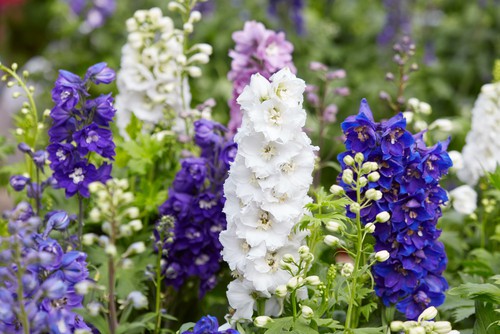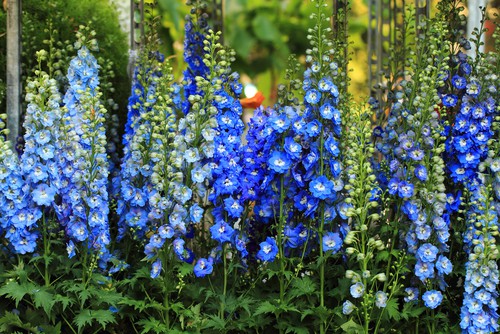Last updated on March 28th, 2022
Our site is reader supported, this means we may earn a small commission from Amazon and other affiliates when you buy through links on our site.
Delphiniums are best planted outside and typically seen in larger gardens, but that doesn’t mean you can’t grow them in containers. In fact, growing Delphiniums in pots is quite easy, as long as you have a large enough container. Like most perennials, they prefer space to accommodate the shallow, wide root structures which is why it’s important to make sure that you pick a suitable container and ideally one that is deep so you can insert canes to support the tall flowers.
Preparing your container for your Delphiniums
As mentioned, the root structure for a Delphinium is shallow and wide so you need to make sure the containers are big enough to allow for this wide root development but are also perfect for the retention of moisture. When you have picked a container, cover the drainage holes with things like crockery from broken pots, stone or even polystyrene and then add a few centimetres of good quality compost.

Choosing the best compost for Delphiniums in containers
Integrate potting mix into the container and press it against the sides to create a hole in which your Delphinium will go. You want a mixture that is one part John Innes potting compost, one part perlite or grit, and one part peat. You could skip the peat and just ensure you add plenty of perlite or grit to the compost to ensure it is well-draining and the soil is able to retain moisture and nutrients.
Potting the Delphinium
The best time for this is the beginning of spring when the plant is dormant or just starting to shoot. You can also do this in summer but keep a close eye on watering.
Step 1
Carefully fill the container you have purchased from your nursery or garden centre and slowly remove the Delphinium from its old pot. You don’t ever want to use tools to loosen the plant from its old container because this can damage the roots and they can be damaged easily. Once you have it removed, you can loosen any parts that are tangled or matted and this will help it root into the new compost once planted.
Step 2
Put your Delphinium in its container and make sure that the top of the roots rest just above the soil but right below the top rim of your container. Once everything is situated, fill the container with the remainder of your potting compost. Press it down firmly to make sure it is stabilised around the plant and there are no air pockets, but be careful not to overdo this because it can actually make it difficult for the plant to root.
Supporting the tall flowers
Be sure to give your plant something for support and structure as the flowers can get very tall and have a tendency to flop over. The best way to support a Delphinium is to use three stakes that make a triangular shape. As mentioned, these plants tend to get very tall so you want to make sure they are properly supported. You can pick things like green flower sticks or bamboo canes and these are available from all garden centres and DIY stores.

Watering and Food
Delphiniums need thorough watering when the weather is warm and there are periods without much rain (sometimes even daily watering if it is summer) and a lot of food. You can simply use a multi-purpose feed every two to three weeks during the growing season, however, it can help to push a few slow-release fertiliser tablets into the soil in spring.
No products found.
The best place to position container-grown delphiniums
The position of your Delphiniums is important. The plants need a decent amount of sunlight, between 4 and 5 hours each day.
Protecting Delphiniums over winter
You can grow your Delphiniums outdoors throughout the year but in winter they need to be protected from the frost by either bringing them into a greenhouse or at the very least placing them in a sheltered area of the garden and wrapping the pots in bubble wrap or lagging to protect the roots. Delphiniums grown in the ground get all the protection they need from the soil but when grown in pots they do become more vulnerable.
Dealing with mildew
Mildew is a common problem with Delphiniums but there is not that much you can do about it. We recommend spraying them with a fungicide as soon as you notice mildew, you will see a powdery white substance on the leaves and you need to remove any badly affected leaves. This process can be fairly effective.
Delphiniums make stunning plants as long as you take good care of them. The best part is that once in containers, they will last up to 5 years, and midway through their lifespan they can be divided and transplanted so you have even more plants to enjoy
Last update on 2025-06-30 / Affiliate links / Images from Amazon Product Advertising API









1 Comment
Can you tell me please. With young delphinium plants. How many stems should I let the plant have to ensure a strong plant?
Thank you